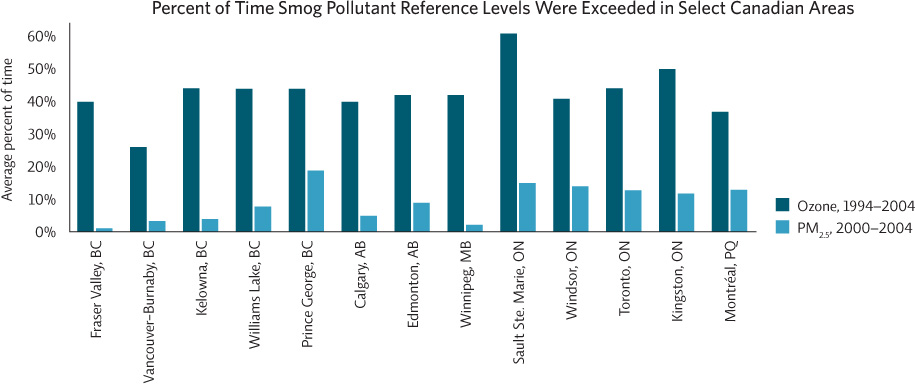SCIENCE LITERACY WORKING WITH DATA
The graph shown here indicates levels of ground-level ozone and particulate matter that exceeded national reference levels (the levels above which health or ecosystem problems occur) in areas and cities in Canada.

Interpretation
Question 20.15
What does the y-axis represent? Choose a city and describe the data for that city.
The y-axis represents the average percentage of time that smog pollutants were above the Reference Level. For example, in Fraser Valley, ground level ozone exceeded the standard 40% of the time, and PM 2.5 exceeded the standard about 2% of the time.
Question 20.16
The legend states that PM2.5 data is given for 4 years. PM stands for particulate matter. The number 2.5 represents the size of the particulate. From a health standpoint, why are the PM2.5 values reported?
2.5 is the size of the particulate in particulate matter in microns (μm). 2.5 μm is very small and can cause significant health problems. The EPA collects data for a range of PM sizes. The smaller sizes are often reported because they can penetrate lung and cardiovascular tissue and wind up in the bloodstream: see InfoGraphic 21.3.
Question 20.17
How many years of data are graphed for ozone? For particulate matter? Does the difference in the amount of time over which the data have been collected make a difference in your interpretation of these data?
10 years are graphed for ozone, and 4 are graphed for PM. If you were looking for trends, 4 years is not very long.
Advance Your Thinking
Question 20.18
Which city would be the worst for your health, based on its levels of pollution? Why?
Sault Ste. Marie, because it has the highest levels of ozone pollution and has relatively high PM 2.5 pollution as well.
Question 20.19
Based on the type of pollution present, what can you predict about the causes of pollution in Sault Ste. Marie versus Montréal? (Hint: Find the two cities on a map and compare the sizes of the cities, their weather, and their primary industries.)
Sault Ste. Marie has lots of industry, including steel manufacturing, paper mills, and melamine and furniture production. The population is ~ 75,000. Average temperatures in the summer are 75°F with high relative humidity.
Montréal is a center for the video game industry, film and television, pharmaceuticals, telecommunications, electronic goods, and aerospace. The population is ~ 3 million. Average temperatures in the summer are 75-80 °F with high relative humidity.
A lot of ground level ozone is actually produced by vehicles, so based on population size you might predict that Montréal would have more days with high ozone levels. However, the types of industry in Sault Ste. Marie contribute more to air pollution and make up for the difference in number of vehicles.